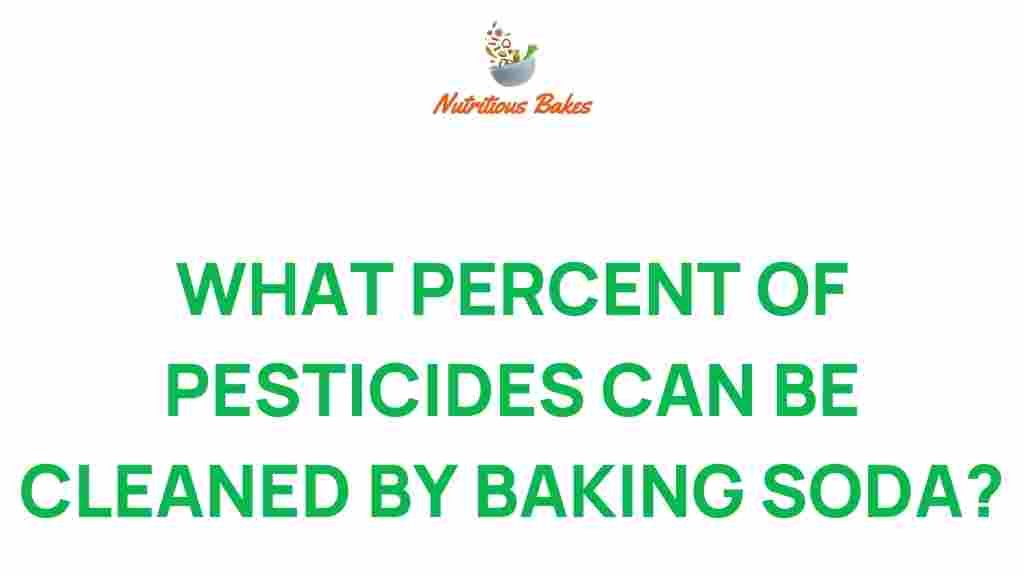Unveiling the Truth: Can Baking Soda Remove Pesticides from Your Produce?
When it comes to food safety, the question of how to effectively clean our produce from harmful residues, including pesticides, is paramount. With growing concerns about health benefits and the safety of our food supply, many people are turning to natural cleaning methods. One popular method is using baking soda to clean fruits and vegetables. But can baking soda really remove pesticides from your produce? In this article, we will delve into the effectiveness of baking soda in removing pesticides, exploring its benefits, and providing useful kitchen tips for safe food preparation.
Understanding Pesticides on Produce
Pesticides are chemicals used in agriculture to protect crops from pests, diseases, and weeds. While they can increase crop yields, they also leave residues on fruits and vegetables that may pose health risks if consumed. The FDA and EPA monitor pesticide levels in food, but consumers often want to take additional steps to ensure their produce is clean and safe.
The Role of Baking Soda
Baking soda, or sodium bicarbonate, is a common household item known for its versatility in cooking and cleaning. Its mild alkaline nature makes it effective at breaking down certain chemical residues, which raises the question: can it effectively remove pesticides from our produce? Let’s explore the science behind this cleaning method.
How to Use Baking Soda to Clean Produce
Using baking soda as a cleaning method for your produce is simple and requires minimal ingredients. Here’s a step-by-step guide:
Materials Needed
- Baking soda
- Water
- A large bowl or basin
- A soft brush or cloth (optional)
Step-by-Step Process
- Prepare the Solution: For every cup of water, add one teaspoon of baking soda. You can adjust the quantities based on the amount of produce you have.
- Soak the Produce: Place your fruits or vegetables in the solution and let them soak for about 10-15 minutes. This allows the baking soda to penetrate and break down pesticide residues.
- Scrub if Necessary: For items with thicker skins, such as cucumbers or potatoes, you may want to use a soft brush to scrub the surface gently.
- Rinse Thoroughly: After soaking, rinse the produce under cool running water to remove any baking soda and remaining residues.
- Dry the Produce: Use a clean cloth or paper towel to dry your fruits and vegetables before storing them.
What Produce Can Benefit from Baking Soda?
While baking soda can clean a variety of fruits and vegetables, some are particularly beneficial to clean this way:
- Leafy Greens: Spinach, lettuce, and kale can hold onto dirt and pesticides.
- Berries: Strawberries, blueberries, and raspberries often have pesticide residues.
- Root Vegetables: Carrots, potatoes, and beets benefit from a thorough wash.
Health Benefits of Cleaning Produce with Baking Soda
Using baking soda as a cleaning method offers several health benefits:
- Reduces Chemical Residues: Washing produce with baking soda can significantly lower the levels of pesticide residues.
- Improves Food Safety: By ensuring that your produce is clean, you reduce the risk of foodborne illnesses.
- Natural and Non-Toxic: Baking soda is a safe, non-toxic alternative to chemical cleaners.
The Science Behind Baking Soda and Pesticide Removal
A study published in the Journal of Agricultural and Food Chemistry found that soaking fruits and vegetables in a baking soda solution was effective in removing certain pesticide residues. The alkaline nature of baking soda disrupts the chemical bonds of pesticide molecules, making them easier to wash away.
Kitchen Tips for Safe Food Preparation
In addition to using baking soda, here are some kitchen tips to enhance food safety during food preparation:
- Buy Organic When Possible: Organic produce is less likely to have pesticide residues. Support organic gardening practices to promote sustainable agriculture.
- Wash Your Hands: Always wash your hands before handling food to prevent cross-contamination.
- Use Separate Cutting Boards: Designate one cutting board for raw meat and another for fruits and vegetables.
- Store Produce Properly: Keep fruits and vegetables in the refrigerator to slow down spoilage and growth of pathogens.
Troubleshooting Common Issues
While using baking soda is generally safe and effective, you may encounter some issues. Here are some troubleshooting tips:
Problem: Produce Still Tastes Bitter or Chemical-Like
Solution: Ensure that you are rinsing the produce thoroughly after soaking. Residual baking soda can affect the taste of fruits and vegetables.
Problem: Not Sure About the Right Concentration
Solution: If you are unsure about the right amount of baking soda, start with a smaller concentration. Use 1 teaspoon of baking soda in 2 cups of water and adjust as needed.
Problem: Sensitive Skin or Allergies
Solution: If you have sensitive skin, consider wearing gloves while cleaning produce with baking soda.
Conclusion
In conclusion, baking soda can be an effective cleaning method for removing pesticides from your produce, enhancing food safety and promoting health benefits. By following the simple steps outlined in this article, you can ensure your fruits and vegetables are clean and safe for consumption. Remember to incorporate other kitchen tips for safe food preparation, and consider supporting organic gardening practices to minimize pesticide use in the first place.
For more information on food safety and healthy eating, check out our food safety guidelines. Happy cooking!
This article is in the category Tips and created by NutritiousBakes Team

1 thought on “Unveiling the Truth: Can Baking Soda Remove Pesticides from Your Produce?”